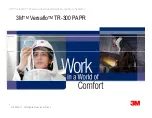
• Only for use by trained competent personnel.
• Leave the contaminated area immediately if:
a) Any part of the system becomes damaged.
b) Airflow to the face piece decreases or stops.
c) Breathing becomes difficult or increased breathing
resistance occurs.
d) Dizziness or other distress occurs.
e) You smell or taste contaminants or irritation
occurs.
• Never modify or alter this product. Replace parts only
with original 3M spare parts.
• Do not use these products in oxygen or
oxygen-enriched atmospheres.
• In case of intended use in explosive atmospheres,
contact 3M.
• Very high work rates (where the pressure within the
face piece can become negative) can reduce
protection.
• Materials which may come into contact with the
wearer's skin are not known to cause allergic
reactions to the majority of individuals.
• These products do not contain components made
from natural rubber latex.
• Do not use with beards or other facial hair that
may inhibit contact between the face and the
product thus preventing a good seal.
• Do not use for escape purposes.
• Do not use these products with self-contained
breathing apparatus.
National regulations may impose specific limitations on
the use of filters depending on the filter class and the
facepiece used. Use of any 3M™ Face piece / Filter
combination should be in accordance with applicable
Health and Safety standards, AS/NZS 1715, Respiratory
Selection Tables or in accordance with the
recommendations of an Occupational Hygienist. Ensure
the face piece is replaced when necessary. Filters need
to be regularly changed. The frequency of change
depends on usage time and the concentration of
contaminant. For more information call the 3M Tech
Assist Helpline 3M Australia 1800 024 464, 3M New
Zealand 0800 364 357.
NOTE
See all instructions for use and save for continuing
reference.
PREPARATION FOR USE
Inspection
Check the apparatus is complete, undamaged and
correctly assembled. If damaged, replace the apparatus.
The following inspection procedure is recommended
before use: 1. Examine the inhalation and exhalation
valves for cracking or tearing. Lift valves and inspect
valve seat for dirt or cracking. 2. Ensure that the head
straps are intact and have good elasticity. 3. Examine all
plastic parts for signs of cracks or fatigue. Undertake
pre-use checks on filters as outlined in the appropriate
user instruction.
OPERATING INSTRUCTIONS
Cartridge Assembly and Removal
1. Snap the cartridge or filter holder (3M 3700) into the
inhalation port of the respirator. A snapping sound will
ensure that the cartridge is secure. Make certain that the
cartridge alignment mark is aligned with the respirator.
(See Fig 1 ). 2. To remove cartridge/particulate filter
retainer, grasp the base of the cartridge and pull with an
upward motion. (See Fig 2).
FITTING INSTRUCTIONS
Fitting Instructions must be followed each time the
product is worn. Select most appropriate size from the 2
sizes of face piece available (S-M / M-L). 1. Place the
respirator over the nose and mouth, fitting it comfortably
on the bridge of the nose, then pull the head harness
over the crown of the head. 2. Take a bottom strap in
each hand, place the straps at the back of the neck and
hook the straps together. 3. Tighten straps by pulling on
ends to achieve a comfortable and secure fit. (See Figs 3
- 5)
FIT CHECK
4.
Perform a Negative Pressure Fit Check.
Place palm of hand over the circular opening of the
cartridge/grill on the front of the particulate filter holder,
inhale gently and hold your breath for five to ten
seconds. If the face piece collapses slightly a proper fit
has been achieved. See Figure 6. If an air leak is
detected, reposition the respirator on the face and / or
re-adjust the tension of the elastic strap to eliminate the
leakage. Repeat the above fit check.
^
If you CANNOT achieve a proper fit DO NOT enter
the hazardous area. See your supervisor. For information
regarding fit testing procedures, please contact 3M. It is
recommended that wearers should be fit tested in
accordance with AS/NZS 1715.
DOFFING
^
Do not remove the face piece, or filters until you
have vacated the contaminated area.
1. Release the tension on the head straps. 2. Unhook the
bottom straps. 3. Carefully lift face piece off the face and
remove the respirator by lifting up and away from the
face.
NOTE
If the respirator has been used in an area that has
caused it to become contaminated with a substance
requiring special decontamination procedures it
should be placed in a suitable container and sealed
until it can be decontaminated or discarded.
CLEANING AND DISINFECTION
Cleaning is recommended after each use. If the
respirator is to be used for more than one shift it should
be cleaned at the end of each shift and stored between
shifts in the original packaging or a sealed container.
Disassemble by removing the cartridge, filter, headband,
inhalation valve and the exhalation valve. To clean the
70









































